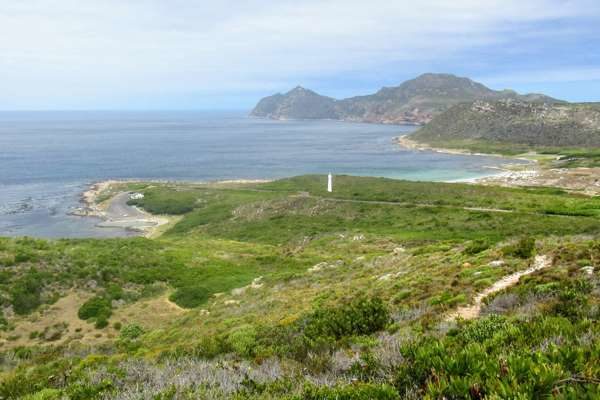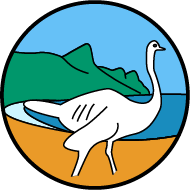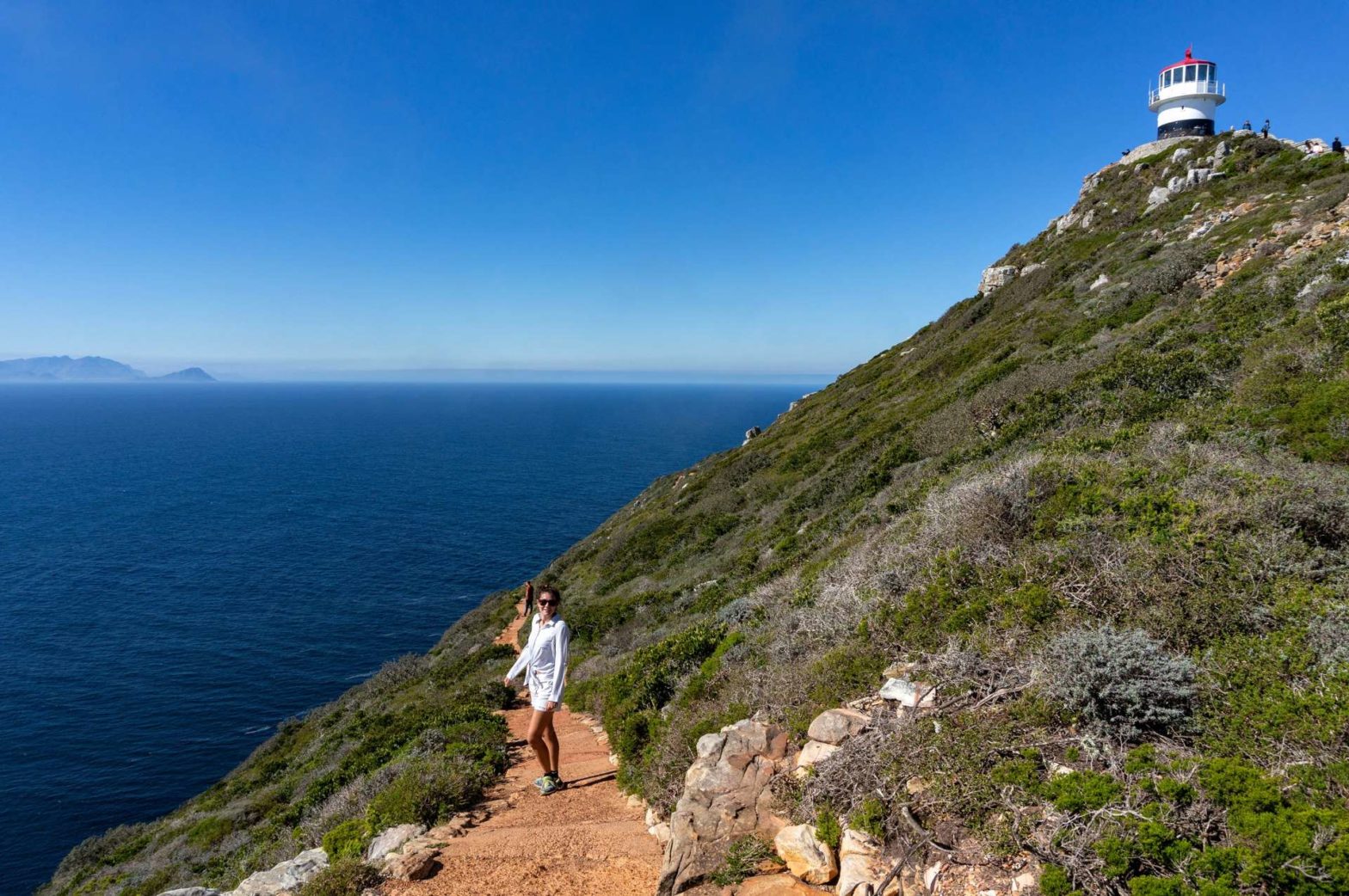By Tom · Published Sep. 26th, 2021 · Updated Nov. 24th, 2022
When you buy through links highlighted with an asterisk (*) on this site, we may earn a small affiliate commission at no cost to you.
This Cape Point guide tells you all you need to know for a trip to the stunning last part of the Cape Peninsula. The fynbos covered Cape Point is not only famous for its lighthouses but also its dazzling cliffs, rocky shore and sandy beaches.
Page Contents:
Location
Cape Point or the Cape of Good Hope is a section of Table Mountain National Park. The entrance gate to this section of the park is about 1 hours drive to the south from the centre of Cape Town. Simon’s Town, famous for its penguins, is the nearest town to Cape Point.
Check out the interactive guide map below to familiarize yourself with Cape Point.
Cape Point National Park Map
Need to Know
- Cape Point is part of Table Mountain National Park.
- The entrance gate hours are 06:00 to 18:00 from October to March and 07:00 to 17:00 from April to September.
- Adhere to the closing time indicated at the gate to avoid paying a fine.
- Entrance fee: Free for WildCard holders, R85/40 for South Africans, R340/170 for foreigners (adults/children)
- Visit the Buffelsfontein Visitor Centre for additional information on activities and the history and nature of Cape Point.
- Sunhat, sunscreen and water are needed in sunny weather.
- On warm sunny days, swimming in one of the tidal or rock pools is an excellent way to cool off.
- For navigation, most hiking trails can be found on the offline maps app Maps.me.
- There is a restaurant* and a take-away food shop near the bottom station of the funicular.
- There is also a curio shop, a post box and a payphone near the bottom station of the funicular.
- There are no ATMs or fuel stations in the park.
We have visited Cape Point on multiple occasions throughout the years, to do the various hikes Cape Point has to offer and of course for the views at the very end. We are sharing our experiences and things to do in this guide below.
How to Get There
Cape Point is a bit out of the way if you are in Cape Town. But don’t worry, the way there is part of its beauty. Driving along the rugged coastline of the Cape Peninsula is otherworldly.
Self Drive
If you drive yourself, you have two route choices: Take the M4 along False Bay coast via Simons Town or go via the M65 through Kommetjie on the Atlantic side. That being said, both routes are beautiful so best take one on the way there and the other on the way back. If you don’t have a car, you can rent one*.
Hire a Car via Rentalcars.com
Make the most of your visit to Cape Point and the surrounding area by renting a car* and driving the beautiful roads on the Cape Peninsula. If you want to go on the beautiful hikes in the reserve, driving is the only way to get to most of the starting points.
Take a Guided Tour
There are many private tour operators taking tourists to Cape Point. One of the options is to take a tour with City Sightseeing who operate the hop-on-hop-off buses in Cape Town*. Their Full Day Cape Point Sightseeing Tour* includes a guide and also visits the penguin colony at Boulders Beach. A tour is a great way to see the Peninsula, as you don’t have to organise anything yourself and you’ll get to see all the main sights.
Things to do at Cape Point
1. Viewpoints
The main attractions of Cape Point are its breathtaking views of rocky cliffs, sandy beaches and False Bay. We summarized the best ones in our Cape Point guide.

Old and New Lighthouse
The most famous view of Cape Point is probably the new lighthouse at the very end of the peninsula. Also from the old lighthouse, the views of the rocky promontory and False bay are amazing. Take the Cape Point Lighthouse hike to get there.

Cape of Good Hope
If you don’t mind a little walk up the cliff, the views from the two Cape of Good Hope viewpoints are very worthwhile. The Cape of Good Hope is the most south-westerly point on the African Continent and it was the famous point for ships rounding the cape heading East. There are also great views of Cape Point and the lighthouses from here. Take the Cape Point Loop Hike to visit both the lighthouse and the Cape of Good Hope.

Rooikrans
Rooikrans is the name of some very impressive red cliffs on the False Bay side of the peninsula. The view from the cliffs to the north and the bay is spectacular. There are great views right from the car park, but walk a little along the shore and you will be treated to even more amazing views.

Gifkommetjie
If you want to get away from the crowds and unwind with great views of fynbos covered dunes, rocky shores and sandy beaches, head to Gifkommetje. As the car park is on a hill, it gives you a good vantage point from where to observe the Atlantic ocean side of the peninsula, especially good during sunset.
2. Hit the Beach
There are various great beaches at Cape Point. Although the water is often cold and it is not safe to swim at all beaches, they are a great place to unwind among the beautiful fynbos-covered dunes.
The most famous beach is Dias Beach right between Cape Point and Cape of Good Hope. This beach has a stunning location and is very photogenic. However, it’s not a good idea to swim here due to the treacherous currents.
A little to the north of the point is Platboom Beach, a large sandy beach on the Atlantic Ocean side. Beautiful dunes with fynbos and white sand surround this beach. If you are driving, the best place to get here is from Platboom car park. Another option is to hike here from Cape Point.
Olifantsbos Beach is well away from the hustle and bustle of Cape Point. This small sandy beach on the Atlantic side is a local favourite for surfing. Drive to Olifantsbos car park for direct access to the beach. If you fancy an activity, there are some good hikes starting from here, for instance to see the famous shipwreck a bit south along the coast from here.
The sandy beach at Buffels Bay faces the False Bay side and is more sheltered. It is a good spot for a picnic and if you don’t fancy a dip in the sea, the tidal pool at Buffels Bay is a lovely (and warmer) alternative. A walk along the rocky shore towards Antoniesgat is a great short activity.
3. Shipwrecks at the Cape of Storms


Unfortunately, the weather at Cape Point isn’t always as great as the photos suggest. For ship captains, this can be and was a very frightening and treacherous corner to round, especially due to the winter storms and thick fog banks. There are a total of 26 shipwrecks around Cape Point. Parts of three of them are easily visited by a walk on the beach.
The most famous one is that of the Thomas T. Tucker, a so-called Liberty ship from the USA. These Liberty ships were built in the Second World War to transport supplies to the war zones. On the 27th of November 1942, a thick fog bank was the culprit. They thought they were somewhere near Robben Island when the ship ran ashore at Olifantsbos Point.
What brought down 12 of the 26 ships are the two submerged reefs near Cape Point. One is Bellow’s Rock, three kilometres off the coast from Cape Maclear (just next to Cape of Good Hope).
The other submerged reef is Albatross Rock off the coast from Olifantsbos Point. On the 30th of April 1965, this rock was struck by the Nolloth while transporting its cargo of liquor and general goods. You can visit part of this wreck and that of the Thomas T. Tucker on the Shipwreck Trail.
A bit to the south, you can find the wreck of the Phyllisia, which struck the shore on the 3rd of May 1968. A nice hike starting from Gifkommetjie takes you there.
4. Go Hiking
Cape Point is a great destination for a self-guided hike. Explore the famous promontory by foot or venture away from the crowds, along the rugged coastline and through beautiful fynbos. Check out the hikes we did below.
Additionally, there are a number of other hikes in Cape Point:
- The 5.2km Shipwreck Circuit is a great alternative to the Shipwreck Trail at Olifantsbos Point. Instead of heading the same way back along the beach, this hike loops inland through the fynbos-covered hills.
- Another nice loop hike at Olifantsbos is the 7.7km Sirkelvlei Circuit. This hike heads out to the Sirkelvlei Pan, the largest body of sweet water on the Cape Point Peninsula. It is a good place to see red hartebeest, bontebok, and many different birds.
- If you want to explore more of the coastline, go on a one-way or out-and-back 4km hike from Platboom to Gifkommetjie.
- Lastly, for the avid hiker, there is a two-day 34km hike called the Cape of Good Hope Overnight Hike. It makes a large loop covering both sides of the peninsula. You overnight at the Rooikrans huts. You need to book this hike through SANParks.
5. Take a Ride on the Funicular
As an alternative to walking to the Old Lighthouse, a popular thing to do at Cape Point is the Flying Dutchman Funicular*. It takes you from the lower station car park through dense fynbos up a steep incline. Apparently, it was the first commercial funicular in Africa. It takes about 3 minutes.
6. Swim and Snorkel
What is better than a nice swim after a hot and tiring walk? Therefore, we have summarized the best places to swim at Cape Point in our guide.
Apart from a cold dip in the sea, there are tidal pools at Buffels Bay and Bordjiesrif filled by the sea at high tide. They are quite close to each other and both in a beautiful spot.



Probably the most scenic place for a swim is at Venus Pools. Not only the towering cliffs of Paulsberg but also the sea life in these natural rock pools is quite amazing. Take a mask and snorkel and discover it for yourself. When we went there on a hike, we saw sea stars, sea urchins, many different pretty fish and one very scary-looking fish under a rock.
7. Explore Landmarks
Cape Point has not always been a nature reserve. There are a few noteworthy landmarks on Cape Point that we have included in our guide. Exploring these is a great thing to do.

Da Gama and Dias Cross
These two crosses were erected in the mid-1960s. They commemorate the original crosses erected by Vasco da Gama and Bartolomeu Dias in this area, but which have since disappeared. Da Gama and Dias were the first European explorers to reach the Cape.
The crosses are also navigational beacons for ships in False Bay. When they line up, the crosses point to Whittle Rock, a shipping hazard in False Bay.

Buffelsfontein Lime Kiln
In the early 1800s, the southernmost part of the peninsula was covered by the Buffelsfontein Farm. The land was not very good for farming, but it had one resource in abundance: Lime from seashells on the beach and from Calcrete rock. This lime was used to plaster the houses in Cape Town. This and other lime kilns were used to get the lime out of the shells and Calcrete.
Old and New Cape Point Lighthouse
Why are there two lighthouses at Cape Point? Surely, one is enough? Unfortunately, it wasn’t. The Old Lighthouse on the highest point of the promontory was first lit in 1860. While it seemed a sensible place to put a lighthouse, this area is known for its heavy fog banks. So the lighthouse was often above the clouds and the ships couldn’t see it, resulting in some disasters.
To solve this problem, they built the New Lighthouse at the very end of the promontory, much closer to sea level. This lighthouse was first lit in 1919.
8. Fine Dine or Picnic
The Two Oceans Restaurant* is a very well-rated fine dining place for lunch, right on the Cape Point promontory. The views from the deck over False Bay are splendid. There’s also a take-away food shop which has longer opening hours.
Alternatively, there are some great picnic spots on the peninsula. The two best places for a picnic are Buffels Bay and Bordjiesrif. Locals can often be seen having a braai at Buffels Bay, so if you want to blend in, bring along your braai supplies. Afterwards, you can cool off with a dip in the tidal pools.
Accommodation
Of course, you can stay anywhere in and around Cape Town and explore Cape Point as a day trip. Alternatively, SANParks – the South African National Parks organisation – offers limited accommodation in and just outside the park which is detailed here in this Cape Point Guide.
There are three cottages for rent. The first and most special is the Olifantsbos cottage, which sleeps six people in the main cottage and if needed, another six in the annexe building. This cottage is right on the beach near the famous wreck of the Thomas T. Tucker.
The other two options are the Eland and Duiker cottages in the north of the park. They both sleep six people. These are not on the coast but inland near the staff accommodation.
Just outside the park, SANParks operates the new Smitswinkel Tented Camp*. This environmentally friendly camp has six two-person tents, fully equipped for self-catering.
If you are on doing the Cape of Good Hope Overnight Hike, you are staying in one of the three Rooikrans huts in the south of the park, with great views over False Bay from the Rooikrans cliffs.


I hope you enjoyed our guide to Cape Point Peninsula. For more great places to visit near Cape Town and in South Africa, check out our South Africa Guide.
FAQS: Cape Point Guide
Cape Point is at the very southern end of the Cape Peninsula in South Africa, approximately 50km south of Cape Town.
You can drive from Cape Town in approximately 1 hour or take a guided tour with a private tour operator.
Dogs are not allowed in the Cape Point Section of Table Mountain National Park.
It is famous for the lighthouse at the end of the rocky promontory, the great vistas over the Atlantic ocean and False Bay, the rocky shore and sandy beaches and the beautiful nature.
Cape Point is relatively safe as it is away from the city and behind an entrance gate. However, be aware of baboons stealing your food.
You are allowed to braai at Cape Point, for instance at the Buffels Bay and Bordjiesrif picnic sites.
Cape Point and the Cape of Good Hope are two rocky promontories some 2km apart. Cape Point has the famous lighthouses and the Cape of Good Hope is the most south-westerly point on the African Continent.
In general, that is not necessary as everything is well explained and easy to find.
The entrance gate to Cape Point is open 06:00 to 18:00 from October to March and 07:00 to 17:00 from April to September.
Cape Point is free for WildCard holders, R85/40 for South Africans and R340/170 for foreigners (adults/children).
You can either take the M4 along the False Bay coast via Simons Town or go via the M65 through Kommetjie. Both routes are very scenic.
Enjoy the many viewpoints, see the famous lighthouses, go hiking, swim in the tidal and rock pools, picnic on the beach and spot wildlife.
You can swim in two tidal pools and in natural rock pools, as well as at some beaches, but there are no lifeguards. It is dangerous to swim at the beautiful Dias Beach near Cape Point.
It is safe to be on the beach but don’t attempt to swim here as there are strong currents.
No, the Atlantic and Indian Oceans meet at Cape Agulhas, some 150km east of Cape Point.
No, Cape Agulhas is the most southerly point on the African Continent, some 150km east of Cape Point.













Good day
Would like to enquire prices for laughing a boat at buffels bay ?
And what papers do you guys neet from the boat ? Survey or bounce papers needed?
Hi Jeandre, I don’t know the answers to these questions. Your best bet would be to enquire with SAN Parks – a list of their local contact details can be found here: https://www.sanparks.org/parks/table_mountain/about/contact.php . I would first try calling or emailing the Wild Card, Activity Permit and Green Card Sales people.
I hope that helps.